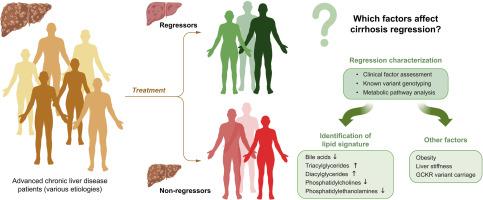Metabolic phenotyping of patients with advanced chronic liver disease for better characterization of cirrhosis regression
IF 26.8
1区 医学
Q1 GASTROENTEROLOGY & HEPATOLOGY
引用次数: 0
Abstract
Background & Aims
Regression of cirrhosis has been observed in patients with viral and non-viral etiologies of liver disease in whom the underlying cause of liver injury was effectively suppressed. However, the understanding of the factors contributing to reversibility of fibrosis and cirrhosis is limited. Our aims were to assess clinical factors, perform genotyping of known variants, and comprehensive metabolic phenotyping to characterize the regression of fibrosis in patients with compensated advanced chronic liver disease (cACLD).
Methods
In a case-control pilot study of 81 patients with cACLD, we compared individuals exhibiting histological or clinical evidence of cACLD regression ("regressors"; n = 44) with those showing no improvement ("non-regressors"; n = 37) after a minimum of 24 months of successful treatment of the cause of liver disease. Data were validated using an external validation cohort (n = 30).
Results
Regardless of the cause of cACLD, the presence of obesity (odds ratio [OR] 0.267 95% CI 0.072-0.882; p = 0.049), high liver stiffness (OR 0.960, 95% CI 0.925-0.995; p = 0.032), and carriage of GCKR variant rs1260326 (OR 0.148, 95% CI 0.030-0.773; p = 0.019) are associated with a reduced likelihood of fibrosis regression in a subgroup of 60 patients with ACLD genotyped for known genetic variants. Using liver tissue transcriptomics, we identified metabolic pathways differentiating regressors from non-regressors, with top pathways associated with lipid metabolism – especially fatty acids, bile acids, phospholipids, triacylglycerides (biosynthesis), and the carnitine shuttle. In the entire discovery cohort, we further measured metabolites within the defined pathways, which led to the identification of 33 circulating markers differentiating regressors from non-regressors after etiological therapy. The validation cohort confirmed 14 of the differentially expressed markers.
Conclusions
We identified and validated a group of lipid biomarkers associated with regression of fibrosis that could be used as non-invasive biomarkers for detecting regression of fibrosis in cACLD.
Impact and implications
Regression of cirrhosis/advanced chronic liver disease (ACLD) after removal of the underlying cause of liver injury has been observed in human cirrhosis. However, detailed characterization of ACLD regression remains an unmet need. In this study, we provide a comprehensive phenotyping of individuals likely to experience ACLD regression. While obesity, carriage of GCKR variant rs1260326 and high liver stiffness were associated with lower likelihood of regression of ACLD, a signature of circulating lipid metabolites enabled differentiation of regressors from non-regressors after effective etiologic therapy. The lipid signature we discovered and externally validated could be used as non-invasive biomarker to detect regression of fibrosis in patients with compensated ACLD.

对晚期慢性肝病患者进行代谢表型分析,以更好地描述肝硬化消退的特征。
背景与目的:在病毒性和非病毒性肝病患者中,如果肝损伤的潜在病因被有效抑制,则可观察到肝硬化的消退。然而,人们对导致肝纤维化和肝硬化可逆性的因素了解有限。我们的目的是评估临床因素,对已知变体进行基因分型,并进行全面的代谢表型分析,以确定代偿性晚期慢性肝病(cACLD)患者纤维化消退的特征:在一项以81名cACLD患者为对象的病例对照试验研究中,我们比较了在成功治疗肝病病因至少24个月后,出现组织学或临床证据表明cACLD消退的患者("消退者",人数=44)和没有改善的患者("未消退者",人数=37)。数据通过外部验证队列(30 人)进行验证:无论cACLD的病因如何,肥胖(OR 0.267 95%CI:0.072-0.882; P=0.049)、肝硬度高(OR 0.960, 95%CI:0.925-0.995; P=0.032)和携带GCKR变异体rs1260326(OR 0.148,95%CI:0.030-0.773;P=0.019)与60例ACLD患者亚组中纤维化消退可能性的降低有关。利用肝组织转录组学,我们确定了区分回归者和非回归者的代谢通路,其中最主要的通路与脂质代谢有关,特别是脂肪酸、胆汁酸、磷脂、三酰甘油(生物合成)和肉毒碱穿梭。在整个发现队列中,我们进一步测量了已定义通路中的代谢物,从而确定了 33 个循环标记物,用于区分病因治疗后的回归者和非回归者。验证队列确认了其中 14 个差异表达的标记物:我们发现并验证了一组与纤维化消退相关的脂质生物标记物,它们可用作检测cACLD纤维化消退的非侵入性生物标记物。
本文章由计算机程序翻译,如有差异,请以英文原文为准。
求助全文
约1分钟内获得全文
求助全文
来源期刊

Journal of Hepatology
医学-胃肠肝病学
CiteScore
46.10
自引率
4.30%
发文量
2325
审稿时长
30 days
期刊介绍:
The Journal of Hepatology is the official publication of the European Association for the Study of the Liver (EASL). It is dedicated to presenting clinical and basic research in the field of hepatology through original papers, reviews, case reports, and letters to the Editor. The Journal is published in English and may consider supplements that pass an editorial review.
 求助内容:
求助内容: 应助结果提醒方式:
应助结果提醒方式:


